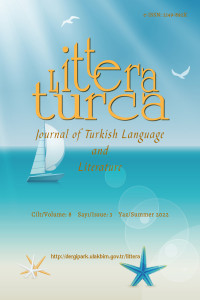THE CONSTRUCTED CHICANA IDENTITY AND MYTH IN THE HOUSE ON MANGO STREET
Bu makale Sandra Cisneros’un (1954–) Mango Sokağı’ndaki Ev (1984) isimli romanını Chicano Hareketi’nin erkek egemen yapısına karşı ortaya çıkan Chicana feminizm ışığı altında incelemektedir. Bu anlamda, Cisneros’un romanı Chicano toplumunun, cinsiyet rollerinin mitik bir şekilde kurgulanmasının ve uyuşturulmuş kadın bilinci üzerine nasıl kurulu olduğunun anlatısı olarak görülebilir. Romanın kahramanı Esperanza, hem kadın hem de erkeklerin haksız davranışlarını gözlemleyerek toplumunda bulunan bu mitlerin farkına varır ve kadınları yalnızca mekânsal değil, düşünsel boyutta da baskılayıp sınırlandıran fosilleşmiş değerleri görür. Kadınlara mal ve cinsel nesne olarak davranıldığını anlar ve buna karşı çıkarak toplum yapısını yeniden kurmada yeni yollar bulmaya karar verir. Cisneros, mikrokozmik Mango Sokağı’nda kurgulanmış kadın imgelerini ve bu bozuk anlayışa karşı duruşunu yansıtır. Kurgulanmış rolleri sonlandırmak adına, kadınlara farkındalık, çözüm üretme, değişim ve eylemi işaret eder.
Anahtar Kelimeler:
Chicana Feminizm, Sandra Cisneros, Mango Sokağı'ndaki Ev, Mit, Kadın
THE CONSTRUCTED CHICANA IDENTITY AND MYTH IN THE HOUSE ON MANGO STREET
This article deals with Sandra Cisneros’s (1954 – ) novel The House on Mango Street (1984) in terms of Chicana feminism, which emerged as a reaction against the male-dominated structure of Chicano Movement. In this sense, Cisneros’s novel can be regarded as a narration of how the Chicano society is built upon mythical constructions of gender roles, the paralyzed consciousness of women. The protagonist of the novel, Esperanza becomes aware of these myths in her society by observing the wrongful behaviors of both women and men and realizes these fossilized values, which suppress the women both spatially and intellectually. She sees that the women are treated like commodities and sexual objects and decides to react and find a new way to reconstruct the community. Cisneros reflects the constructed women images in the microcosmic Mango Street and her stand against this corrupted consideration. As a way of breaking the constructed roles, she implies awareness, remedy, change, and action for the women.
Keywords:
Chicana Feminism, Sandra Cisneros, The House on Mango Street, Myth, Woman,
___
- Anaya, Rudolfo (1993). Growing Up Chicana/o, (ed. Tiffany Ana López), New York: Avon Books.
- Anzaldúa, Gloria (1987). Borderlands/La Frontera: The New Mestiza, San Francisco: Spinsters/Aunt Lute Book Company.
- Alarcón, Norma (1990). “The Theoretical Subjects of This Bridge Called My Back and Anglo-American Feminism”. Criticism in the Borderlands: Studies in Chicano Literature, Culture, and Ideology, (eds. Hector Calderón and José David Saldívar), Durham, N.C.: Duke University Press, 28-39.
- Cisneros, Sandra (1984). The House on Mango Street, NY: Vintage Books.
- -------- (1996) “Guadalupe the Sex Goddess”. La Diosa de las Americas, (ed. Ana Castillo). New York: Riverhead Books, 43-46.
- Cotera, Marta (1977). The Chicana Feminist, Austin, TX: Austin Information Systems Development.
- Dunbar, Roxanne (2000). “Female Liberation as the Basis for Social Revolution”. Radical Feminism: A Documentary Reader (ed. Barbara A. Crow), New York: New York University Press, 486-493.
- Garcia,Alma M. (1989). “The Development of Chicana Feminist Discourse, 1970-1980” Gender and Society, 3.2, (Jun.), 217-238.
- -------- (1997). Chicana Feminist Thought, The Basic Historical Writings, (ed.) Great Britain: Routledge.
- Garcia, Richard A. (1977). The Chicanos in America, 1540-1974, NY: Oceana Publications.
- Herrera-Sobek, Maria (1987). “The Politics of Rape: Sexual Transgression in Chicana Fiction.” The Americas Review, 15. 3-4, 171-188.
- López, Tiffany Ana. (1993). Growing Up Chicana/o, (ed. Tiffany Ana López) New York: Avon Books.
- Moi, Toril (1986). “Feminist Literary Criticism”, Modern Literary Theory, (eds. Ann Jeferson and David Robey), London: Batsford, 204-221.
- Moraga, Cherríe (1993). “The Last Generation” The Lost Generation, Boston: South End Press, 56-59.
- Nieto, Consuelo (2014). “The Chicana and Women’s Rights Movement” Chicana Feminist Thought: The Basic Historical Writings, (ed. Alma M. Garcia) NY: Routledge, 206-211.
- Nieto-Gomez, Anna (1974). “La Feminista”, Encuentro Femenil 1, pp, 34-47.
- -------- (1976). “Sexism in the Movement.” La Gente 6(4), pp, 10.
- Olivares, Julian (1996). “Entering The House on Mango Street” Teaching American Ethnic Literature, (eds. John R. Maitino and David R. Peck), Albuquerque: University of New Mexico Press.
- Petty, Leslie (2000). “The ‘Dual’ing Images of La Malinche and la Virgin de Guadalupe in Cisneros’ The House on Mango Street” MELUS 25.2 (Summer), 119-132. (02.02.2020)
- Rodriguez-Aranda, Pilar E. (1990). "On the Solitary Fate of Being Mexican, Female, Wicked and Thirty-three: an Interview with the Writer Sandra Cisneros." The Americas Review 18.1, pp, 64-80.
- Rowbotham, Shelia (1974). Woman, Resistance and Revolution: A History of Women and Revolution in the Modern World, NY: Vintage.
- Saldívar, Ramon (1990). Chicano Narrative: The Dialectics of Difference, Madison, WI: The University of Wisconsin Press.
- Yayın Aralığı: Yılda 4 Sayı
- Başlangıç: 2015
- Yayıncı: Bahir SELÇUK
Sayıdaki Diğer Makaleler
ÜSLUPBİLİM (STİLİSTİK) VE NECİP FAZIL KISAKÜREK’İN ŞİİRLERİ ÜZERİNDE STİLİSTİK BİR İNCELEME
DERVȊŞ MAHFȊ VE MUHTÂR-NÂME’Sİ
NASREDDİN: EFENDİ’NİŊ GÜRRÜŊLERİ. (MÜTERCİMİ A. ALİYEV). 1-NCİ ÇAP. AŞGABAT – 1913/1914. 24 S.
“SÜLEYMAN GİRYÂNÎ NECMÜ’L-KULÛB (İnceleme-Metin)”
PROF. DR. BAHİR SELÇUK - UZM. NURTEN ÇELİK, Nergisî’nin Kîmyâ-yı Sa’âdet Çevirisi İKSÎR-İ DEVLET
SEYYİD YAHYÂ VÂKIF EFENDİ VE HALEP MENZİL-NÂMESİ
MUSA YAKUB ŞİİRLERİNDE TOPRAĞIN KİMLİKSEL DÖNÜŞÜMÜ: VATAN
